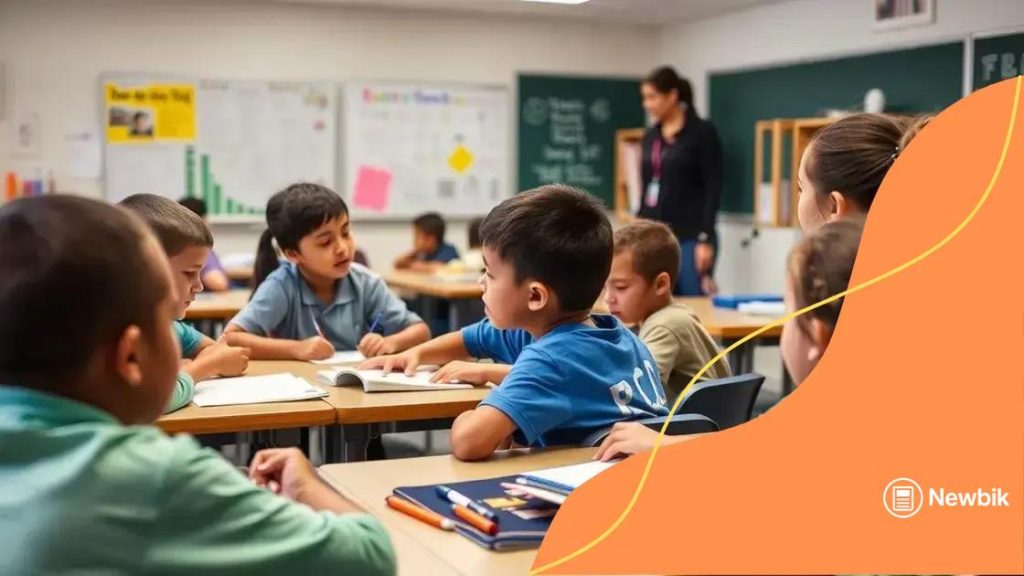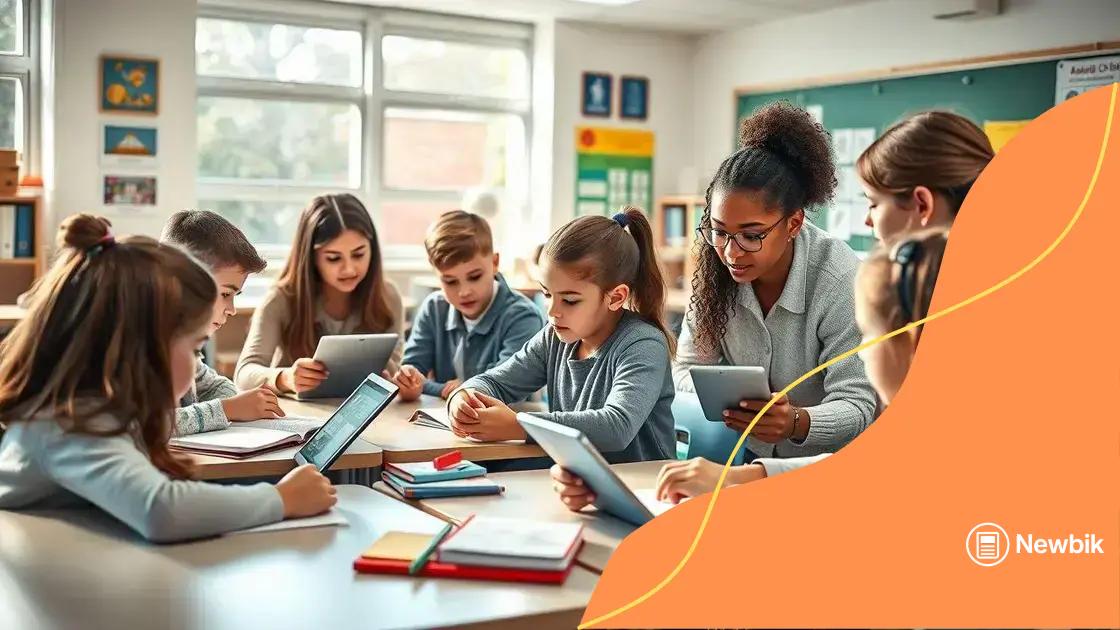Addressing pandemic learning loss: effective strategies

Addressing pandemic learning loss requires innovative teaching techniques, active parental involvement, and a strong focus on social-emotional learning to support students’ recovery and ensure their academic success.
Addressing pandemic learning loss is essential for students to thrive in their academic journeys. Many learners faced significant challenges during remote education, so it’s vital to explore methods that can help them regain their footing. Ready to dive into practical solutions?
Understanding pandemic learning loss
Understanding pandemic learning loss is crucial to effectively address the challenges faced by students during the COVID-19 crisis. The shift to remote learning led to significant disruptions that affected educational progression and emotional well-being.
The impact of learning loss varies widely among different groups of students. Some children thrived in online settings, while others struggled without in-person support. Recognizing these differences can help educators tailor their approaches to better serve all learners.
Key Factors of Learning Loss
Several factors have contributed to the challenges students faced:
- Inequitable access to technology and resources.
- Emotional and social challenges affecting concentration.
- Learning environment differences, such as home distractions.
- Loss of engagement in academic activities.
These factors can lead to gaps in knowledge and skills that affect long-term academic success. Understanding these elements is pivotal for re-engaging students and meeting their educational needs.
It’s important to take a comprehensive view of how pandemic learning loss has shaped students’ experiences. Assessing both academic and emotional growth will help educators design interventions that are both effective and empathetic.
Collaboration among teachers, parents, and community members is essential for guiding students back on track. Frequent communication can ensure everyone is aware of the challenges and successes students are experiencing as they navigate their educational journeys.
Ultimately, by addressing the underlying issues of learning loss, we can collectively work toward sustainable recovery and improved educational outcomes for all students.
Identifying key areas of impact
Identifying key areas of impact is crucial in understanding how the pandemic has affected student learning. During the last few years, schools faced unprecedented challenges, and their ripple effects can still be felt today. Look at how these impacts have shaped educational experiences and outcomes.
One major area of concern is academic performance. Many students fell behind in key subjects, particularly in mathematics and literacy. The loss of in-person instruction and consistent support has led to skill gaps that need urgent attention.
Social and Emotional Well-being
In addition to academic challenges, the pandemic has taken a toll on students’ social and emotional well-being:
- Isolation has led to increased feelings of loneliness and anxiety.
- Difficulty building relationships due to limited social interactions.
- Stress caused by changing learning environments.
- Limited access to mental health resources.
The importance of addressing these issues cannot be overstated. Schools must create supportive environments where students feel safe to learn and express their needs.
Another critical area is the educational equity gap. Students from low-income families often faced greater obstacles during remote learning, such as lack of technological access. This disparity has widened existing gaps in achievement, making it essential to focus resources where they are needed most.
Moreover, teachers encountered difficulties in adapting their teaching methods. Professional development and training are vital to help educators develop skills for effective distance learning. Finding new ways to engage students, even in a virtual space, can help maintain educational momentum.
As we work to remedy the situation, it’s vital to monitor these impacts continually. By understanding the key areas of impact, we can tailor interventions, support, and resources to foster a more equitable and effective learning environment.
Strategies to mitigate learning loss

Effective strategies to mitigate learning loss are essential to support students as they recover from the impacts of the pandemic. Schools are now more focused on implementing enhanced learning techniques that cater to students’ diverse needs. Tailoring approaches can help ensure that all students regain their footing.
One strategy is to enhance individualized learning. This can be achieved through personalized lesson plans that address specific learning gaps. Teachers can assess each student’s strengths and weaknesses to create targeted exercises and activities that promote growth.
Utilizing Technology
Another important strategy involves incorporating technology into the classroom:
- Online tutorials can provide additional resources for students who need extra help.
- Interactive learning platforms encourage engagement and motivate students to practice independently.
- Virtual study groups enable peer collaboration and support.
- Learning management systems facilitate streamlined communication between teachers and students.
Effective use of technology can create a more dynamic learning environment and help bridge gaps in knowledge.
Furthermore, schools can implement after-school programs tailored to address specific learning needs. These programs offer additional resources and engagement opportunities for students who may struggle to keep pace during regular hours. Incorporating a variety of activities, such as tutoring or hands-on projects, can foster a love for learning.
Engagement and Support
It is also crucial to promote familial and community involvement. When parents and caregivers are engaged in their children’s education, student performance often improves. Schools can host workshops that educate families about how to support learning at home.
Additionally, mental health resources should be integrated within schools. Understanding the emotional needs of students is vital to their academic success. Providing counseling services can help alleviate anxiety and improve focus, enabling students to better engage with their studies.
By implementing these strategies, schools can work towards reducing the impact of learning loss and ensuring that every student achieves their full potential. Continuous monitoring and adjustments are key to finding what works best for each unique learning environment.
Role of parents and community involvement
The role of parents and community involvement is vital in addressing learning loss following the pandemic. Engaged parents can significantly influence their children’s academic success by providing support and encouragement at home. When parents are active participants in their children’s education, it creates a strong link between home and school.
Communication is key. Regular updates from teachers about student progress help parents stay informed. This can be achieved through newsletters, virtual meetings, or parent-teacher conferences. Understanding what their children are learning allows parents to contribute positively at home.
Building a Supportive Home Environment
Creating a conducive environment for learning at home can help students refocus:
- Setting a regular study schedule helps establish a routine.
- Providing necessary resources, like books and technology, supports academic needs.
- Encouraging open discussions about school fosters a positive attitude towards learning.
- Participating in homework can help address specific challenges.
In addition to parental involvement, community resources can play a crucial role in supporting education. Schools can partner with local organizations to provide additional programs and resources, such as tutoring, mentorships, and enrichment activities. These collaborations can bridge gaps that might exist due to limited school resources.
Moreover, engaging with local businesses can provide funding, materials, or mentorship programs that enhance the educational experience. Opportunities for students to connect with the community can promote real-world learning and expose them to various career paths.
Creating a Collaborative Network
Organizing community events encourages joint efforts between schools, families, and local organizations. Events such as workshops, resource fairs, or family engagement nights strengthen ties and show the importance of collaboration. When families feel included and valued, they are more likely to invest time and energy into their children’s education.
In summary, the active participation of parents and the community can significantly impact students’ recovery from pandemic-related learning loss. By fostering strong partnerships and promoting open communication, we can create a supportive network that nurtures student success.
Innovative educational techniques
Innovative educational techniques are essential in helping students recover from learning loss caused by the pandemic. As classrooms evolve, educators are increasingly embracing new methods that engage students and foster a love for learning. These techniques ensure that learning is relevant, dynamic, and accessible to all.
One popular approach is project-based learning (PBL). This technique encourages students to work on real-world projects that relate to their interests and the curriculum. By collaborating in groups, students develop critical thinking, problem-solving, and teamwork skills. This hands-on experience makes learning more meaningful and enjoyable.
Integrating Technology
Another significant innovation is the integration of technology into learning:
- Flipped classrooms allow students to learn new content at home through videos and then practice skills in the classroom with teacher support.
- Gamification uses game-like elements to make learning fun and competitive, motivating students to complete tasks.
- Online collaborative tools, like Google Classroom, enable students to work together, even from different locations.
- Virtual reality (VR) provides immersive experiences, allowing students to explore subjects in a hands-on way.
These technological advancements create more engaging learning environments, encouraging students to take ownership of their education.
Furthermore, personalized learning pathways allow students to progress at their own pace. This tailored approach helps accommodate different learning styles. By providing choices in topics or assessment methods, students can engage more deeply with the material, leading to better retention and understanding.
Social-Emotional Learning
Incorporating social-emotional learning (SEL) techniques is also vital. These techniques help students develop self-awareness, self-regulation, and interpersonal skills. Activities such as mindfulness practices, group discussions, and peer feedback create a supportive environment. When students feel safe emotionally, they are more likely to engage and participate actively in their education.
Overall, using innovative educational techniques fosters a stimulating atmosphere that encourages creativity, collaboration, and critical thinking. With the right approach, educators can significantly help students recover from learning loss and build the skills they need for a successful future.
FAQ – Addressing Pandemic Learning Loss
What are some effective strategies to mitigate learning loss?
Innovative teaching methods, personalized learning, and involved parents and communities can significantly help address learning loss.
How can parents get involved in their child’s education?
Parents can engage by communicating with teachers, supporting homework routines, and participating in school events.
What role does technology play in addressing learning loss?
Technology enhances learning through interactive platforms, online resources, and flexible learning environments.
Why is social-emotional learning important now?
Social-emotional learning helps students cope with anxiety and fosters a positive mindset, which is crucial for academic success.